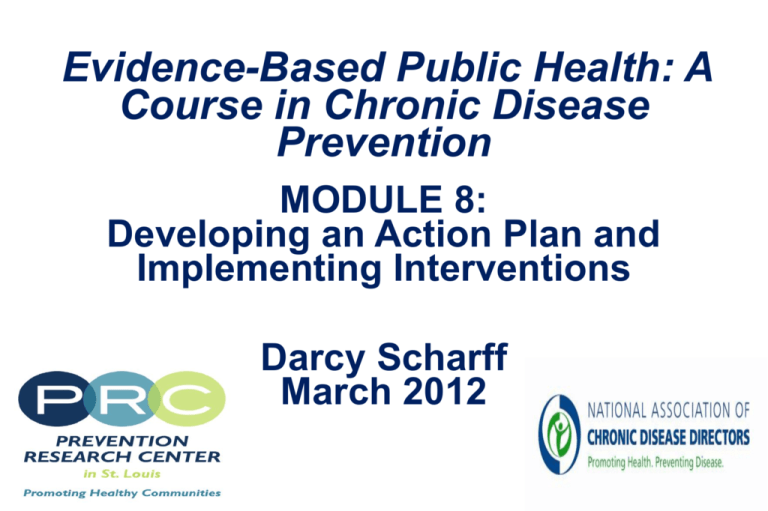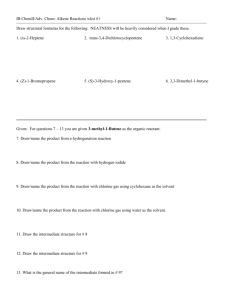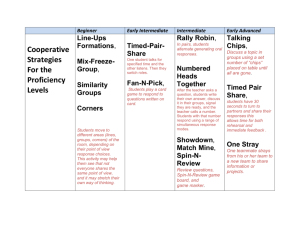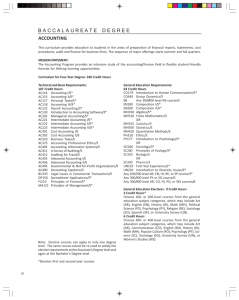Module #8: Developing an Action Plan and Implementing Interventions
advertisement

Evidence-Based Public Health: A Course in Chronic Disease Prevention MODULE 8: Developing an Action Plan and Implementing Interventions Darcy Scharff March 2012 Learning Objectives 1. Identify key characteristics and principles in successful action planning. 2. Understand the purpose and use of logic models. 3. Describe steps used in constructing logic models. 2 Learning Objectives 1. Identify key characteristics and principles in successful action planning, including the role of coalitions/ partnerships. 3 Action versus ongoing planning Action planning for a defined program or policy with specific, time dependent outcomes Ongoing or strategic planning a regular function within an organization 4 Importance Changeability 5 Key characteristics of effective action planning Plans that clearly spell out and make linkages across goal objectives action strategies Roles and responsibilities of important stakeholders clarified (timetables, training) Clear mechanisms for tracking progress (evaluation) Action plans based on evidence and assessment 6 In planning, remember to link evidence with programs Data Interpretation Data Analysis Data Collection Program Evaluation Information Dissemination Program Implementation Program Planning 7 Key Principles of Planning Assessment should guide the development of programs Community members should participate in the process Program should be developed with key partners or as part of coalitions (builds infrastructure for change) Participants should develop a comprehensive intervention strategy- but may implement one step at a time 8 Key Principles of Planning (cont) Evaluation should emphasize feedback and program improvement The community capacity for health promoting changes should be increased – skill transfer between community & academic/practice partners (two way) 9 Aspects of Effective Coalitions Build a sense of community Enhance community member engagement – mechanisms for true involvement Strong leadership – decision making, conflict management Provide vehicle for community empowerment Diversity valued and celebrated Incubator for innovative solutions to large problems flexible and responsive 10 Aspects of Failed Coalitions Individuals/organizations have different expectations of coalition No clear direction or goals Ineffective or unchanging leadership No involvement of those effected by the programs/ policies Focus on unrealistic, distant outcomes 11 Learning Objectives 1. Identify key characteristics of successful action planning 2. Understand the purpose and use of logic models 12 Logic model: Definition Diagram depicting interrelationships between goal -longer term public health outcomes objectives -shorter term intervention impacts action strategies Also called Analytic framework Causal frameworks 13 Purpose of logic model Aids in program planning Guides steps of data collection Defines evaluation process Map to linkages on which to base conclusion about intervention effectiveness Linkages represent ‘causal pathways’ Identifies primary and intermediate effects 14 Inputs Activities Outputs Outcomes Short-Term Educational classes Financial Resources Human Resources Informational Resources Newsletters Media campaign Workshops Seminars Coalition building, advocacy, etc. Completed Activities Examples: • # of people participating in each event •# of newsletters distributed •Amount of air time or number of media events • # of workshops/semin ars conducted • # letters • # meetings Increased knowledge, skills and abilities Intermediate Increase in physical activity and healthy eating (behavior) Long-Term Decrease in Obesity Goal Reduce type-2 diabetes Logic Model (Analytic Framework) Worksheet: Evidence-Based Public Health Program Title:__________________________________________ Goal: Long-Term Objective: What are the evidencebased determinants? Intermediate Objective (Environmental Level): Activities: Activities: Activities: Activities: Costs: Costs: Costs: Costs: Evaluation Intermediate Objective (Govt./Org. Level): Process How much will it cost? What other resources are needed d? Intermediate Objective (Social Level): Impact Based on an evidence review, what activities will address these determinants? What do you do? How long will it take? Intermediate Objective (Individual Level): Instructions: First discuss your target population. Using data, evidence-based recommendations (the Community Guide or others), your own knowledge, and group discussion, develop a program strategy for controlling diabetes in your community. Define the goal, objectives, activities, and costs: and describe them in this sample logic model. 16 Learning Objectives 1. Identify key characteristics of successful action planning 2. Understand the purpose and use of logic models 3. Describe steps used in constructing logic model 17 Step1: What is the goal of your program What are the health issues facing your community? What is the magnitude of the problem? Who is most affected, geographic differences, time trends? What are the consequences of the problem? What causes it? How do you find the answers to these questions? 18 Step 2: Prioritization Group process to prioritize which problem(s) to work on key components: importance and changeability priorities 19 Helpful websites Community Engagement: Community Analysis and Needs Assessment See the Community toolbox – http://ctb.ku.edu/ 20 Step 3: Setting specific objectives a. What are objectives? There must be sound scientific evidence to support the objectives, should be appropriate for community The result to be achieved should be important and understandable to a broad audience Objectives should be prevention-oriented Objectives should drive action and suggest a set of interim steps (intermediate indicators) 21 Step 3: Setting specific objectives a. What are objectives?(cont) The language of objectives should be precise, avoiding use of general or vague verbs Objectives should be measurable and may include a range of measures—health outcomes, behavioral risk factors, health service indicators, and assessments of community capacity Specific timetables for completion of objectives should be described SMART 22 Step 3: Setting specific objectives a. What are objectives?(cont) Example of a sound objective: To reduce the percent of women, ages 35 to 55, who are overweight (BMI>24.9) from 80% in 2000 to 70% in 2010. Objectives are achievements, not activities The what, not the how 23 Step 3: Setting specific objectives a. What are objectives?(cont) Consider “intermediate” objectives if we promise too much in outcomes, we are destined to fail What are intermediate objectives for the BMI example (what do we need to accomplish to reduce BMI)? more on this in evaluation 24 Step 3: Setting specific objectives b.Consider strategies based on theory Theories explain behavior suggest ways to effect change guide intervention strategies guide development of objectives (e.g.,suggest what needs to be done to change behavior) 25 Transtheoretical Model Stages of Change Individual level theory Precontemplation - information Contemplation –information, cognitive restructuring – identity as a smoker/non-smoker Preparation- skill building (recipes) Action- skill building, environmental cues Maintenance- above plus social norms 26 Social Cognitive Theory Cognitive processes & behavior Social support Environment Create change through- Role modeling/observational learning Group meetings Reducing exposure to key triggers 27 Strategies at Various Levels Individual Interpersonal Organizational Objectives Address - knowledge - attitudes - behavior - practices - social support - social networks - programs - practices - policies Approaches - brochures - training - counseling - develop new social ties - lay health advisors - peer support groups - org change - networking - development 28 Strategies at Various Levels (cont) Community Policy/Governmental Objectives Address - programs - environment - policies - regulations - ordinances - policies - legislation Approaches - infrastructure - media advocacy - community development - political action - lobbying - policy advocacy 29 Step 3: Setting specific objectives a. What are objectives?(cont) Examples of intermediate objectives (promoting activity) – based on theoretical constructs: Knowledge Increase the percentage of individuals reporting they understand the health benefits of physical activity from 40% in 2010 to 50% in 2015. Attitudes/intentions to change Increase the percentage of people reporting they intend to become physically active in the next six months from 12% in 2010 to 22% in 2015. 30 Step 3: Setting specific objectives c. Consider strategies that others have used and the local population and context Community guide Feasibility/Practicality Adapt to local environment, policies, cultures, norms 31 Step 4: Developing Action Strategies Be sure to show the link between goals, objectives & strategies (check using logic model) Developing the evaluation plan (covered tomorrow) Consider specific costs associated with each of the action steps planned 32 Example In order to decrease diabetes (goal) We need to increase fruit & vegetable consumption (objective) By increasing knowledge about and access to fruits and vegetables (objective) To increase knowledge we will …(action strategy) To increase access we will …(action strategy) 33 Logic Model (Analytic Framework) Worksheet: Evidence-Based Public Health Program Title:__________________________________________ Goal: Long-Term Objective: What are the evidencebased determinants? Intermediate Objective (Environmental Level): Activities: Activities: Activities: Activities: Costs: Costs: Costs: Costs: Evaluation Intermediate Objective (Govt./Org. Level): Process How much will it cost? What other resources are needed d? Intermediate Objective (Social Level): Impact Based on an evidence review, what activities will address these determinants? What do you do? How long will it take? Intermediate Objective (Individual Level): Instructions: First discuss your target population. Using data, evidence-based recommendations (the Community Guide or others), your own knowledge, and group discussion, develop a program strategy for controlling diabetes in your community. Define the goal, objectives, activities, and costs: and describe them in this sample logic model. 34 Step 4: Developing Action Strategies Developing the work plan and timetables Basic time line construction includes A complete listing of activities, grouped by major categories Ascertaining which activities need to be done first Determining how long each activity will take Determining when each and every activity is to begin and finish Establishing the time units that are most appropriate (e.g., weeks, months, years) 35 Step 4: Developing Action Strategies Assessing resource needs 1. Available funds: how many direct funds are available? What are the sources? Are there limitations on how and when funds can be spent? Are funds internal or external to your program or agency? 2. Personnel: how many and what types of personnel are needed? What type of training will be needed for program staff? Are there “in-kind” funds? What personnel do collaborating organizations bring to the project? 3. Equipment and materials: what types of equipment and supplies are needed for the program? Are there certain pieces of equipment that can be obtained “in-kind” from participating partners? 36 Step 4: Developing Action Strategies Assessing resource needs (cont) 4. Facilities: for some types of interventions, significant infrastructure is needed in the form of clinics, hospitals, or mobile vans. These need to be carefully considered as they can amount to a significant expense. 5. Travel: is there travel directly related to carrying out the project? Are there related travel expenses for other meetings or presentations in professional settings? 37 Step 4: Developing Action Strategies Identifying and training workers In which areas does each staff member need training? Who should conduct the training? Do some people have unused skills that could be useful to your program? How best should community members be oriented and trained regarding your program? How can training be time efficient? 38 Step 4: Developing Action Strategies Reasons for piloting 1. Refine the original hypotheses and/or research questions 2. Produce information that will help improve evaluation approaches 3. Improve curriculum materials or evaluation instruments 4. Test approaches for data imputation and analysis 39 Step 4: Developing Action Strategies Reasons for piloting (cont) 5. Uncover politically sensitive issues 6. Estimate costs for people, equipment, materials, and time 7. Ascertain the cultural appropriateness of interventions in diverse populations by inclusion on program development 8. Enhance the “marketability” of an intervention with senior agency administrators when a pilot test is successful 40 Resources Turn to ready-made resources Community tool box http://ctb.ku.edu/ Community Health Promotion Kit http://www.health.state.mn.us/divs/fh/chp/hpkit/ Guidelines for Comprehensive Programs to Promote Healthy Eating and Physical Activity http://www.astphnd.org/programs/guidelines.htm 41 Logic Model (Analytic Framework) Worksheet: Evidence-Based Public Health Program Title:__________________________________________ Goal: Long-Term Objective: What are the evidencebased determinants? Intermediate Objective (Environmental Level): Activities: Activities: Activities: Activities: Costs: Costs: Costs: Costs: Evaluation Intermediate Objective (Govt./Org. Level): Process How much will it cost? What other resources are needed d? Intermediate Objective (Social Level): Impact Based on an evidence review, what activities will address these determinants? What do you do? How long will it take? Intermediate Objective (Individual Level): Instructions: First discuss your target population. Using data, evidence-based recommendations (the Community Guide or others), your own knowledge, and group discussion, develop a program strategy for controlling diabetes in your community. Define the goal, objectives, activities, and costs: and describe them in this sample logic model. 42




